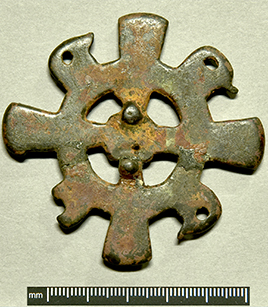Mogao caves

The Nestorian bronze cross unearthed at the northern section of the Mogao Grottoes Photo: Liang Xushu/DUNHUANG ACADEMY
The Mogao Grottoes in Dunhuang are divided into the southern and northern sections. In the north, although there are hundreds of caves on a cliff spanning over 700 meters, most have been ignored due to the absence of murals and statues.
The caves in the northern section can be classified into six types. (1) 65 residential caves specifically for monks or locals who resided in the Mogao Grottoes, featuring kang bed-stoves [a traditional heated platform used for general living, working, entertaining and sleeping in northern China], stoves, and evidence of fire. (2) Meditation caves for monks to practice meditation and recitation, which can be further categorized into single-room (totaling 68) and multi-room (totaling 10) caves, featuring meditation beds without stoves and traces of fire. (3) Combination caves that serve both as living quarters and meditation spaces, totaling of 9 caves. (4) Burial caves for monks, lay disciples, and other Buddhist followers, amounting to 23 caves. (5) Worship caves for Buddhist followers to worship, make pilgrimages, and hold other Buddhist activities, characterized by murals or sculptures. (6) Storage caves used for storing items, including 2 caves containing storage compartments made of adobe.
Numerous artifacts have been unearthed from the caves in the northern section, including Persian silver coins, Western Xia iron coins, Western Xia ceramics, wooden seals inscribed with Western Xia script, 48 wooden movable type blocks with Old Uyghur script, Tibetan Buddhist scriptures written in ni-yin and ni-jin pigments [silver/golden pigments made from silver/gold fine powder and glue], and the Old Uyghur Buddhist scriptures written in ni-jin pigments. Research suggests that the Persian silver coins were minted during the reign of Peroz I, the Sasanian King of Kings (shahanshah) of Iran from 459 to 484. The presence of these Persian silver coins in Dunhuang may be related to the interactions between the Tang Empire and Sogdian merchants on the Silk Road. In addition, a Nestorian bronze cross from the 12th century and two pages of hymns in the Syriac Bible from the Yuan Dynasty have been unearthed from the northern section, providing important materials for the study of early Christianity in China.
